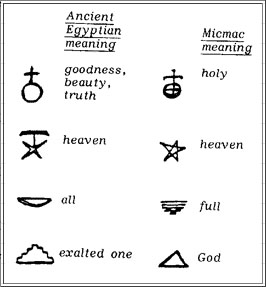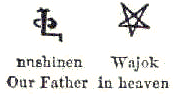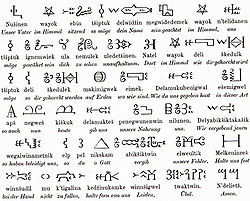
Mi'kmaq hieroglyphic writing
Encyclopedia
Míkmaq hieroglyphic writing was a writing system and memory aid used by the Míkmaq, a Native American
people of the east coast of what is now Canada.
The missionary-era glyphs were logogram
s, with phonetic elements used alongside (Schmidt & Marshall 1995), which included logographic, alphabet
ic, and ideographic
information. They were derived from a pictograph and petroglyph
tradition. In Mi'kmaq the glyphs are called komqwejwi'kasikl, or "sucker-fish writings", which refers to the tracks the sucker fish leaves on the muddy river bottom.
, rather than as a pictographic mnemonic
device. In the 17th century, French missionary Chrétien Le Clercq
adapted the Míkmaq characters as a logographic system for pedagogical purposes.
In 1978, Ives Goddard
and William Fitzhugh of the Department of Anthropology
at the Smithsonian Institution
, contended that the pre-missionary system was purely mnemonic, as it could not be used to write new compositions. Schmidt and Marshall argued in 1995 that the missionary system of the 17th century was able to serve as a fully functional writing system. This would mean that Míkmaq is the oldest writing system for a native language north of Mexico.

in New France from 1675, claimed that he had seen some Míkmaq children 'writing' symbols on birchbark
as a memory aid. This was sometimes done by pressing porcupine quills directly into the bark in the shape of symbols. Le Clercq adapted those symbols to writing prayers, developing new symbols as necessary.
This adapted writing system proved popular among Míkmaq, and was still in use in the 19th century. Since there is no historical or archaeological evidence of these symbols from before the arrival of this missionary, it is unclear how ancient the use of the mnemonic glyphs was. The relationship of these symbols with Míkmaq petroglyph
s is also unclear.
Pierre Maillard
, Roman Catholic priest, during the winter of 1737-38 perfected a system of hieroglyphics to transcribe Mi'kmaq words. He used these symbols to write formulas for the principal prayers and the responses of the faithful, in the catechism
, so his followers might learn them more readily. In this development he was greatly aided by Jean-Louis Le Loutre
, another French missionary. There is no direct evidence that Maillard was aware of Le Clercq's work; in any event Maillard's work is outstanding in that he left numerous works in the language, which continued in use among the Mi'kmaq into the 20th century.
and epigrapher Barry Fell
, who claimed that various pre-Columbian
inscriptions in the Americas were written by Europeans, argued that Míkmaq hieroglyphic writing was not only pre-Columbian but Egyptian
in origin. Mainstream epigraphers and others rejected Fell's claims as baseless. (Goddard & Fitzhugh, Schmidt & Marshall). A web page called Egyptians in Acadia offers an illustration of some of Fell's claims (apparently taken from Fell 1992 (cited on that same page). Comparison with the Egyptian hieroglyphs shows that Fell's claims have significant shortcomings. The description below describes the facts of the use of the Egyptian Hieroglyphs which Fell cited.
Indigenous peoples of the Americas
The indigenous peoples of the Americas are the pre-Columbian inhabitants of North and South America, their descendants and other ethnic groups who are identified with those peoples. Indigenous peoples are known in Canada as Aboriginal peoples, and in the United States as Native Americans...
people of the east coast of what is now Canada.
The missionary-era glyphs were logogram
Logogram
A logogram, or logograph, is a grapheme which represents a word or a morpheme . This stands in contrast to phonograms, which represent phonemes or combinations of phonemes, and determinatives, which mark semantic categories.Logograms are often commonly known also as "ideograms"...
s, with phonetic elements used alongside (Schmidt & Marshall 1995), which included logographic, alphabet
Alphabet
An alphabet is a standard set of letters—basic written symbols or graphemes—each of which represents a phoneme in a spoken language, either as it exists now or as it was in the past. There are other systems, such as logographies, in which each character represents a word, morpheme, or semantic...
ic, and ideographic
Ideogram
An ideogram or ideograph is a graphic symbol that represents an idea or concept. Some ideograms are comprehensible only by familiarity with prior convention; others convey their meaning through pictorial resemblance to a physical object, and thus may also be referred to as pictograms.Examples of...
information. They were derived from a pictograph and petroglyph
Petroglyph
Petroglyphs are pictogram and logogram images created by removing part of a rock surface by incising, picking, carving, and abrading. Outside North America, scholars often use terms such as "carving", "engraving", or other descriptions of the technique to refer to such images...
tradition. In Mi'kmaq the glyphs are called komqwejwi'kasikl, or "sucker-fish writings", which refers to the tracks the sucker fish leaves on the muddy river bottom.
Classification
Scholars have debated whether the earliest known Míkmaq "hieroglyphs" from the 17th century qualified fully as a writing systemWriting system
A writing system is a symbolic system used to represent elements or statements expressible in language.-General properties:Writing systems are distinguished from other possible symbolic communication systems in that the reader must usually understand something of the associated spoken language to...
, rather than as a pictographic mnemonic
Mnemonic
A mnemonic , or mnemonic device, is any learning technique that aids memory. To improve long term memory, mnemonic systems are used to make memorization easier. Commonly encountered mnemonics are often verbal, such as a very short poem or a special word used to help a person remember something,...
device. In the 17th century, French missionary Chrétien Le Clercq
Chrétien Le Clercq
Father Chrétien Le Clercq , a Franciscan Récollet, and a zealous Roman Catholic missionary to the Mi'kmaq on the Gaspé peninsula in the mid-17th century, was also a distinguished historiographer of Nouvelle France who wrote two early histories and adapted an apparently native mnemonic glyph system...
adapted the Míkmaq characters as a logographic system for pedagogical purposes.
In 1978, Ives Goddard
Ives Goddard
Robert Hale Ives Goddard, III is curator emeritus in the Department of Anthropology of the National Museum of Natural History at the Smithsonian Institution. He is widely considered the leading expert on the Algonquian languages and the larger Algic language family.-Early life and education:Ives...
and William Fitzhugh of the Department of Anthropology
Anthropology
Anthropology is the study of humanity. It has origins in the humanities, the natural sciences, and the social sciences. The term "anthropology" is from the Greek anthrōpos , "man", understood to mean mankind or humanity, and -logia , "discourse" or "study", and was first used in 1501 by German...
at the Smithsonian Institution
Smithsonian Institution
The Smithsonian Institution is an educational and research institute and associated museum complex, administered and funded by the government of the United States and by funds from its endowment, contributions, and profits from its retail operations, concessions, licensing activities, and magazines...
, contended that the pre-missionary system was purely mnemonic, as it could not be used to write new compositions. Schmidt and Marshall argued in 1995 that the missionary system of the 17th century was able to serve as a fully functional writing system. This would mean that Míkmaq is the oldest writing system for a native language north of Mexico.

History
Father le Clercq, a Roman Catholic missionary on the Gaspé PeninsulaGaspé Peninsula
The Gaspésie , or Gaspé Peninsula or the Gaspé, is a peninsula along the south shore of the Saint Lawrence River in Quebec, Canada, extending into the Gulf of Saint Lawrence...
in New France from 1675, claimed that he had seen some Míkmaq children 'writing' symbols on birchbark
Birch bark document
A birch bark document is a document written on pieces of birch bark. Such documents existed in several cultures. For instance, some Gandharan Buddhist texts have been found written on birch bark and preserved in clay jars....
as a memory aid. This was sometimes done by pressing porcupine quills directly into the bark in the shape of symbols. Le Clercq adapted those symbols to writing prayers, developing new symbols as necessary.
This adapted writing system proved popular among Míkmaq, and was still in use in the 19th century. Since there is no historical or archaeological evidence of these symbols from before the arrival of this missionary, it is unclear how ancient the use of the mnemonic glyphs was. The relationship of these symbols with Míkmaq petroglyph
Petroglyph
Petroglyphs are pictogram and logogram images created by removing part of a rock surface by incising, picking, carving, and abrading. Outside North America, scholars often use terms such as "carving", "engraving", or other descriptions of the technique to refer to such images...
s is also unclear.
Pierre Maillard
Pierre Maillard
Abbé Pierre Antoine Simon Maillard was a French-born Roman Catholic priest. He is noted for his contributions to the creation of a written language for the Mi'kmaq indigenous people of Île Royale, Cape Breton Island, Canada....
, Roman Catholic priest, during the winter of 1737-38 perfected a system of hieroglyphics to transcribe Mi'kmaq words. He used these symbols to write formulas for the principal prayers and the responses of the faithful, in the catechism
Catechism of the Catholic Church
The Catechism of the Catholic Church is the official text of the teachings of the Catholic Church. A provisional, "reference text" was issued by Pope John Paul II on October 11, 1992 — "the thirtieth anniversary of the opening of the Second Vatican Ecumenical Council" — with his apostolic...
, so his followers might learn them more readily. In this development he was greatly aided by Jean-Louis Le Loutre
Jean-Louis Le Loutre
Abbé Jean-Louis Le Loutre was a Catholic priest and missionary for the Paris Foreign Missions Society...
, another French missionary. There is no direct evidence that Maillard was aware of Le Clercq's work; in any event Maillard's work is outstanding in that he left numerous works in the language, which continued in use among the Mi'kmaq into the 20th century.
The Fell hypothesis
BiologistBiologist
A biologist is a scientist devoted to and producing results in biology through the study of life. Typically biologists study organisms and their relationship to their environment. Biologists involved in basic research attempt to discover underlying mechanisms that govern how organisms work...
and epigrapher Barry Fell
Barry Fell
Barry Fell was a professor of invertebrate zoology at the Harvard Museum of Comparative Zoology. His primary research was on starfish and sea urchins...
, who claimed that various pre-Columbian
Pre-Columbian
The pre-Columbian era incorporates all period subdivisions in the history and prehistory of the Americas before the appearance of significant European influences on the American continents, spanning the time of the original settlement in the Upper Paleolithic period to European colonization during...
inscriptions in the Americas were written by Europeans, argued that Míkmaq hieroglyphic writing was not only pre-Columbian but Egyptian
Ancient Egypt
Ancient Egypt was an ancient civilization of Northeastern Africa, concentrated along the lower reaches of the Nile River in what is now the modern country of Egypt. Egyptian civilization coalesced around 3150 BC with the political unification of Upper and Lower Egypt under the first pharaoh...
in origin. Mainstream epigraphers and others rejected Fell's claims as baseless. (Goddard & Fitzhugh, Schmidt & Marshall). A web page called Egyptians in Acadia offers an illustration of some of Fell's claims (apparently taken from Fell 1992 (cited on that same page). Comparison with the Egyptian hieroglyphs shows that Fell's claims have significant shortcomings. The description below describes the facts of the use of the Egyptian Hieroglyphs which Fell cited.
Table from Fell  |
Egyptian Hieroglyphs |
Description of Egyptian Hieroglyphs mentioned by Fell and their uses in Egyptian |
|---|---|
| |
Fell's drawing of the Egyptian hieroglyph is not accurate. F35 represents the "heart and windpipe" of a vertebrate animal. F35 is used as shown with phonetic determinatives I9 f 'adder' and D21 r 'mouth' in the word nfr 'good'. When three F35s are used together, it means 'beauty' in Egyptian. Egyptian words meaning 'truth' do not use F35. The Micmac glyph cited by Fell appears not to be an Egyptian Hieroglyph, but rather the Christian symbol Globus cruciger Globus cruciger The globus cruciger is an orb topped with a cross , a Christian symbol of authority used throughout the Middle Ages and even today on coins, iconography and royal regalia... with the Earth (a crossed circle) surmounted by a cross. |
| |
The Hieroglyph N14 is a star; when used alone, it means sb3 'star'; the centre example with N11 j'h 'moon' above the star means 3bd 'month'; the rightmost example, shown with N1 pt 'sky' above the star does not occur. The Egyptian words for 'heaven' and 'sky' do not use the star hieroglyph. The Micmac glyph cited by Fell appears to be an ordinary pentagram Pentagram A pentagram is the shape of a five-pointed star drawn with five straight strokes... star used for 'heaven'; no connection to Egypt is necessary for the Micmac sign to make sense in this context. |
| |
The Hieroglyph V30 represents wickerwork-basket; it is used in the Egyptian word nb 'all'. The Míkmaq ms |
| |
The Hieroglyph O41 represents a double-stairway; it is used in the Egyptian word q3y 'ascent', 'high place', j'r 'ascend'. O41 does not mean 'exalted one' in Egyptian. The Micmac glyph cited by Fell appears to be a triangle, representing the Trinity Trinity The Christian doctrine of the Trinity defines God as three divine persons : the Father, the Son , and the Holy Spirit. The three persons are distinct yet coexist in unity, and are co-equal, co-eternal and consubstantial . Put another way, the three persons of the Trinity are of one being... , and not a set of stairs. |
Examples
 |
 |
External links
- Míkmaq Portraits Collection Includes tracings and images of Míkmaq petroglyphs
- Micmac at ChristusRex.org A large collection of scans of prayers in Míkmaq hieroglyphs.
- Écriture sacrée en Nouvelle France: Les hiéroglyphes micmacs et transformation cosmologique (PDF, in French) A discussion of the origins of Míkmaq hieroglyphs and sociocultural change in the 17th century Micmac society.

